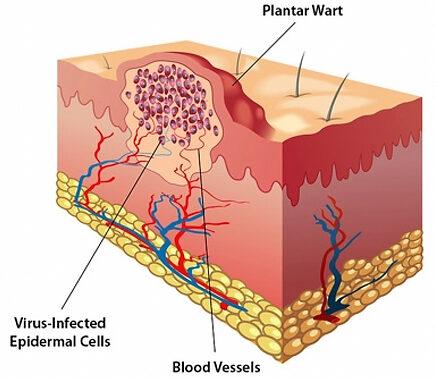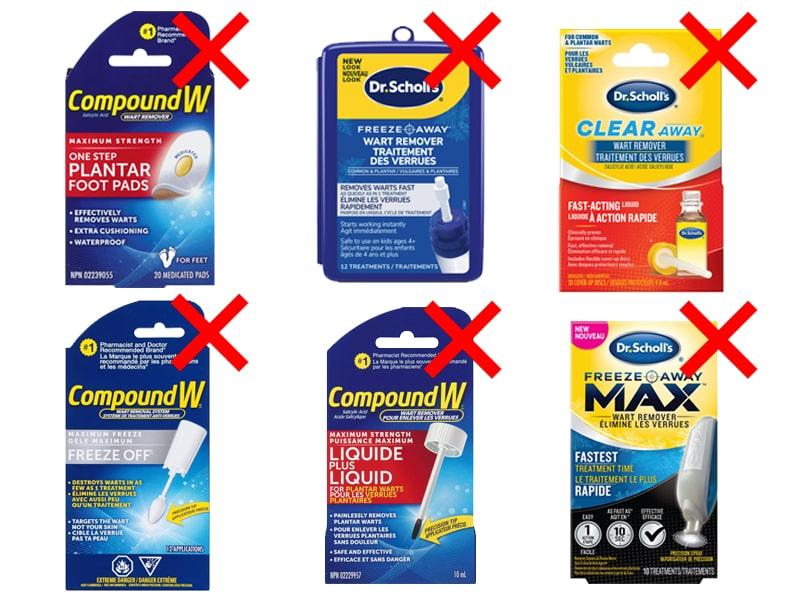Treatment Options for Wart Removal
Plantar warts present for over 6 months tend to be more resistant to treatment compared to those present for a shorter duration (Lipke, 2006).
At Toronto Foot Care, we provide a range of effective treatment options for plantar wart removal. Our dedicated team of chiropodists customizes treatment plans to suit each patient’s unique needs. Factors such as the location and size of the plantar wart, your pain tolerance, and your schedule are carefully considered in order to recommend the most suitable and personalized treatment approach for you.
There are numerous varieties of wart treatments available. Below, we highlight the most common treatments we use, along with others available in the market.

Cantharidin
Cantharidin, derived from the beetle, Cantharis vesicatoria, stands as our primary treatment choice, boasting a cure rate of up to 80% for common plantar warts (Lipke, 2006).
Here’s how it works: Cantharidin induces epidermal cell death and initiates blister formation upon interaction with skin cells. The application process involves paring down the wart and covering it with a bandage for 24 hours. Subsequently, a blister develops and typically heals within 1 to 2 weeks. This procedure is repeated in 1 to 3-week intervals. Notably, the application is painless, does not typically result in scarring, and has reported success rates of 80% for common plantar warts.
Falknor's Needling Method
Understanding that warts can hide on the surface level of the skin, the body may not readily recognize the HPV virus, allowing the wart to persist. Falknor’s needling method is a valuable approach we employ to effectively eliminate persistent and multiple warts. The technique is a direct needling procedure involving local anesthesia to induce physical trauma to a specific wart, without the use of additional chemicals. This method aims to trigger the immune response by introducing controlled injury. Needling one lesion often results in a “cascade” effect, leading to the resolution of other untreated lesions (Baveja et al., 2022).
By utilizing Falknor’s needling method, we leverage the body’s immune response to target and eliminate the wart, offering a unique approach to wart removal. If you are considering this method or seeking more information, our team at Toronto Foot Care can provide insights and guidance tailored to your specific needs.
Surgical Removal by Curettage or Cautery (Wart Excision)
Surgical removal by curettage followed by cautery remains a well-established and commonly utilized method for treating warts. Research, including studies by Patil et al. (2023) and Sterling et al. (2001), has reported success rates as high as 85%. It is essential to note, however, that despite the high success rates, scarring and recurrence are potential concerns, affecting up to 30% of patients.
When considering this approach, it is crucial to weigh the benefits of successful wart removal against the potential drawbacks of scarring and the possibility of the wart returning. If you have questions or are exploring alternative treatments, our team at Toronto Foot Care can provide personalized insights and recommendations based on your specific situation.
Interesting Fact: Warts existing for over 6 months tend to be more resistant to treatment compared to those present for less than 6 months. (Lipke, 2006).
Other Treatment Options for Warts
Over the Counter and Home Remedies for Wart Removal
Due to the protective layers and thickness of the skin on the bottom of the feet, over-the-counter medications and home remedies treatments for warts are often less effective, as they primarily penetrate the outer skin layers only. The challenge lies in reaching the deeper layers where the wart is located.
For more effective treatment, it’s advisable to consider professional guidance and specialized approaches that can address the unique characteristics of plantar warts on the feet.

Salicylic Acid
Salicylic acid is a popular first-line therapy for warts, favoured by both patients and healthcare providers due to its over-the-counter (OTC) availability and cost-effectiveness. However, it’s important to note that even with variations in concentration, ranging from OTC salicylic acid products (up to 15%) to prescribed formulations (up to 60%), the cure rate is estimated to be approximately 15% and can take more than 6 months to notice any results, according to current evidence-based research (Bruggink et al., 2010).
While salicylic acid remains a widely used option, it’s essential to be aware of its efficacy limitations. If you’re seeking alternative or more potent treatments for warts, our team at Toronto Foot Care can provide personalized recommendations based on your specific condition and preferences.
Cryotherapy
Cryotherapy involves the use of extreme cold to induce necrotic destruction of skin cells, prompting a cell-mediated response. Typically, primary care and dermatology offices utilize liquid nitrogen at a temperature of -196°C for wart treatment. OTC solutions like Verruca-Freeze freeze tissue to -70°C and have a slower freezing rate compared to liquid nitrogen.
With the aggressive application, it’s important to be aware of potential adverse effects, including skin colour changes and the risk of tendon or nerve damage. Patients with poor circulation require cautious treatment. The application process itself can be painful due to the extreme cold.
The cure rate for cryotherapy varies, ranging from 34% to 64% based on techniques employed. These techniques differ in application (spray or cotton wool bud), freeze times, and intervals between treatments (Lipke, 2006). Considering these factors, cryotherapy is not typically our first-line treatment for plantar warts. If you have specific concerns or are exploring alternative options, our team at Toronto Foot Care can provide personalized guidance based on your individual needs.
Ready for your first visit?
Book an appointment today or call us at (416) 444-3668 to learn more about our foot care services.
Baveja, S., Bhatt, S., Vashisht, S., Vashisht, D., Joshi, R., Pathania, V., & Venugopal, R. (2022). Falkner’s needling technique for the treatment of warts: Minimum investment, maximum benefit. Medical journal, Armed Forces India, 78(Suppl 1), S75–S81.
Bruggink, S. C., Gussekloo, J., Berger, M. Y., Zaaijer, K., Assendelft, W. J., de Waal, M. W., Bavinck, J. N., Koes, B. W., & Eekhof, J. A. (2010). Cryotherapy with liquid nitrogen versus topical salicylic acid application for cutaneous warts in primary care: randomized controlled trial. CMAJ : Canadian Medical Association journal = journal de l’Association medicale canadienne, 182(15), 1624–1630.
Gelman, A. B., Norton, S. A., Valdes-Rodriguez, R., & Yosipovitch, G. (2015). A Review of Skin Conditions in Modern Warfare and Peacekeeping Operations. Military Medicine, 180(1), 32–37.
Lipke M. M. (2006). An armamentarium of wart treatments. Clinical medicine & research, 4(4), 273–293.
Patil, C.C., Arora, S., Bhatnagar, A., Sandhu, S., Mitra, D., and Suhag, D. (2023). Use of punch in the treatment of plantar warts: A study of 250 cases. Clinical Dermatology Review 7(1): 55-57.
Sterling, J.C., Handfield-Jones, S., and Hudson, P.M. (2001). Guidelines for the management of cutaneous warts. British journal of Dermatology. 144(1): 4-11.
